What Is a Balalaika Instrument?
Folkstrings.com is reader-supported. When you buy through links on our site, we may earn a small commission.
What Is a Balalaika Instrument? The Balalaika is a Russian stringed instrument that is known for its characteristic triangular hollow shape.
This instrument, traditionally, has three strings and is a member of the lute family. The Balalaika instrument developed from the dombra, which is a round-bodied, three-stringed instrument with a long neck.
This instrument is available in six sizes and produces unique sounds that depend on the type of strings, whether Nylon or metal.
Table of Contents
- How Is The Balalaika Played?
- Is the Balalaika Easy to Learn?
- Why Is It Called the Balalaika?
- What Does a Russian Balalaika Sound Like?
- How to Tune Russian Balalaika
- Helpful Videos on Tuning a Balalaika
- What Is a Balalaika Instrument? – Conclusion
How Is The Balalaika Played?
This Russian folk instrument is typically plucked, using the fingers or a leather plectrum. Two of the strings are tuned to the same note, and the third string is tuned to a perfect fourth higher. The six types of balalaikas include the following.
· Piccolo Balalaika
· Prima Balalaika
· Secunda Balalaika
· Alto Balalaika
· Bass Balalaika
· Contrabass Balalaika
The most common solo Balalaika is the Prima, which is tuned: E4–E4–A4. Some guitarists who play Balalaika Prima will tune their instrument in guitar style, using G3–B3–D4. Those who are classically trained on the Balalaika typically avoid guitar style tuning and stick with the traditional.
Is the Balalaika Easy to Learn?
Although with its three strings it would seem the Balalaika would be a simple instrument to play, this is not always the case.
Many people find it takes years of consistent practice to master this Russian instrument. Some people seem to learn to play the instrument naturally, in a short amount of time.
Because it is unique, it is difficult to compare it to other instruments in the same family.
Even if you have played the ukulele or guitar, you are likely to find the Balalaika presents an even greater challenge.
One of the most difficult aspects of learning to play the Balalaika is tremolo on a single string because it is easy for your fingers to move over and hit the adjacent string.
Some people who have large fingers may need to space the strings a little further apart, to ensure they are playable.
It is important to understand the technique involved in playing the Balalaika, particularly a Prima.
Traditionally, musicians use their left thumb to fret their notes on the lower string. When playing the Prima, fretting notes on the lower string is how chords are held. The side of the right index finger is used to strum on the smaller Balalaika instruments, but a plectrum is used to strum the larger versions.
While the Balalaika is often used as an accompanying instrument in orchestras, it also plays beautifully as a solo instrument. Alexey Arkhipovsky is a musician that is well known for his solo performances, playing the Balalaika.
Why Is It Called the Balalaika?
The Balalaika is an instrument that is steeped in Russian tradition.
Multiple characters from Russian folklore are depicted playing the instrument, particularly bears.
Many people wonder why this instrument is called a Balalaika.
Balalaika, in Russian, means babble or jabber.
This instrument is entirely unique in its sound, offering a melodic sound with a soft and even tone that is loved by Russians and people throughout the world.
Not only does its name have a special meaning, but so does its shape. Many believe the three points of the Balalaika represent the Holy Trinity.
Unfortunately, this is likely not the case since the instrument has been banned by the church periodically throughout the years.
A more likely explanation for the shape is that the instrument was originally carved from a pumpkin. To make sense of this, simply quarter a pumpkin and you will see the iconic triangular shape of the Balalaika.
Whatever the meaning behind the shape, it helps to create the beautiful sounds only Balalaikas can produce.
Studying the history of this beautiful instrument will make you want to play it even more. Even if you are unfamiliar with Russian history, it is interesting to study more about this instrument and how it has reached popularity beyond the borders of Russia.
What Does a Russian Balalaika Sound Like?
The sounds produced by the Balalaika are like nothing you will hear from any other instruments.
Just like the human voice, many different sounds can be created from a single instrument.
The reason there are so many different sounds from this instrument is there are different types, and the way a musician plays can have a profound impact on the sound.
Folk Balalaikas are strung with metal strings, and they are tuned differently from those with Nylon strings, making them sound sharper.
When it comes to concert Balalaikas, they are strung with all Nylon strings, which makes them sound much softer. It is almost like the sound of fluttering butterfly wings.
If you play in tremolo style, this transforms the sound coming from the instrument. Tremolo is a popular playing style for Balalaika, but it is possible to play this instrument without the shivering/shaking effect.
Many describe the smallest Prima Balalaika as sounding like a mandolin and a banjo had a love child. When you hear this instrument being played, there is just something about it that draws you in and makes you want to play.
It is important to note that the quality of sound will be determined by the quality of the instrument. If you purchase a very inexpensive Balalaika, you will probably have purchased one that is meant more for decoration than playing.
Musicians need to make sure they take time to research and learn as much as possible about their options before purchasing. To ensure you are purchasing a fine instrument, look for an extended fingerboard because most of the lower models do not have them.
It is also wise to choose a Balalaika that has a raised pickguard because many of the cheaper versions of the instrument have inlaid pickguards.
How to Tune Russian Balalaika
The way a musician tunes a Russian Balalaika will depend on the type. It is important to tune this instrument properly, to ensure it has the best sound.
The following offers information on tuning each type of Balalaika, so musicians will be prepared.
The Prima
The most common Balalaika played is the Prima. It is the instrument that is most widely available, even outside of Russia. You will tune the Prima to EEA. The 2nd and 3rd strings are tuned to the same note.
The Secunda
The Secunda is tuned to AAD. The first string is tuned to D in the first octave. The second string is tuned to A in minor octave. The third string is tuned to A in minor octave. Just like with the Prima, the 2nd and 3rd strings are tuned to the same note.
The Alto
The Alto is tuned like the Prima with EEA. The 2nd and 3rd strings are tuned to the same pitch, which is E in minor octave.
The Bass and Contrabass
You will tune the Bass and Contrabass in the same way. They are both tuned to EAD. The first string is tuned to D in minor octave. The second string is tuned to A in major octave. The third string is tuned to E in major octave.
It is important to note that there are some six-string Balalaikas. These are tuned differently from the three-string varieties.
Six-String
Six-string Balalaikas have six strings with matching pairs. For instance, a Prima is tuned to EEA. But, if you have a six-stringed Prima, you would tune it to EEEEAA. The six-string versions of the Balalaika are tuned to sound melodic, like the mandolin.
Helpful Videos on Tuning a Balalaika
Tuning a Balalaika Prima
Tuning a Balalaika Secunda
Tuning an Alto Balalaika
Tuning a Bass Balalaika
Tuning a Contrabass Balalaika
These videos should help you get the perfect sound for each type of Balalaika. It may take a little practice learning to tune a Balalaika.
If you find it difficult to tune them by ear, try a tuner, and you should find the process much easier, at least until you learn to find the pitch by ear.
What Is a Balalaika Instrument? – Conclusion
Now, you know a lot more about the Balalaika and how it plays.
This instrument is unique in its appearance and sound. If you have never played the Balalaika, this is a perfect opportunity to get started.
To learn how to tune a Balalaika, watch the corresponding videos above.
Once this instrument is tuned properly, you can learn to play all types of folk music, with amazing sounds that transcend other stringed instruments in the lute family.
Author Profile
-
Daniel Johnstone is an English writer with a love for stringed instruments from around the world.
He shares his love for these instruments through his writing for folkstrings.com, a website dedicated to all things related to folk string music.
Daniel's passion for music started at a young age, and he has since become an accomplished musician, playing guitar, cavaco, and recently, the harp.
His dedication to learning and sharing his knowledge of stringed instruments is evident in his insightful and engaging blog posts. Whether you're a seasoned musician or a beginner, Daniel's writing is sure to inspire and entertain you.
When he's not playing music or writing, you can find Daniel exploring new instruments and seeking out new sounds to share with his readers.
Latest entries
 AutoharpApril 4, 2024What Is the Autoharp Made Of: Exploring Its Materials and Craftsmanship
AutoharpApril 4, 2024What Is the Autoharp Made Of: Exploring Its Materials and Craftsmanship AutoharpApril 4, 2024Is Autoharp Easy to Play? Unveiling the Truth for Beginners
AutoharpApril 4, 2024Is Autoharp Easy to Play? Unveiling the Truth for Beginners AutoharpApril 4, 2024What Is an Autoharp Worth? Your Guide to Pricing and Value
AutoharpApril 4, 2024What Is an Autoharp Worth? Your Guide to Pricing and Value AutoharpApril 4, 2024Are Autoharp and Zither the Same Thing? Unraveling String Instrument Myths
AutoharpApril 4, 2024Are Autoharp and Zither the Same Thing? Unraveling String Instrument Myths
Affiliates:
This post may contain affiliate links that at no additional cost to you, the site may earn a small commission. We only recommend products we would use ourselves and all opinions expressed on this site are our own.
Accuracy Advice:
While we strive to provide up-to-date and accurate information, the content in this article may not reflect the most current research or medical guidelines. We encourage readers to do further research and consult with professionals for more personalized advice.
Our Recommendations:
The products and services mentioned in any of our articles are recommended based on our independent research and personal experience. We are not sponsored by any company. We aim to suggest products and services we believe are of high quality and could be beneficial to our readers.

